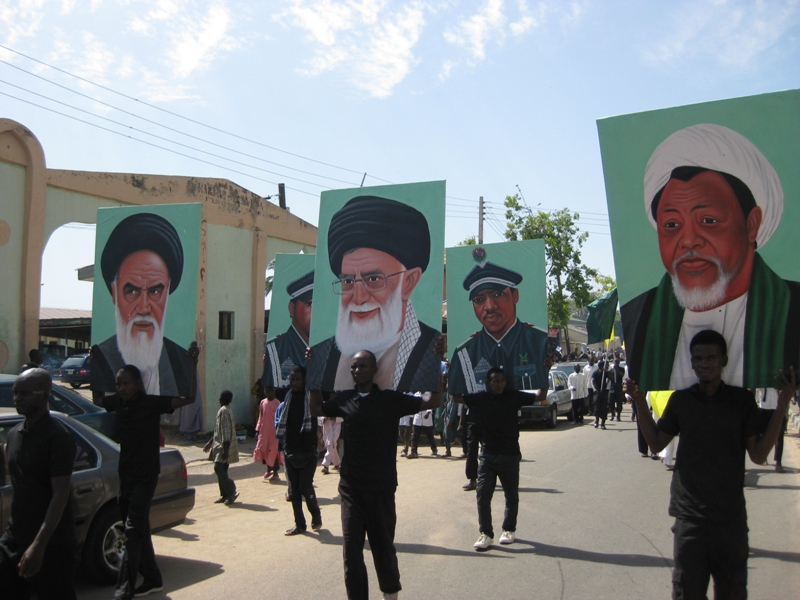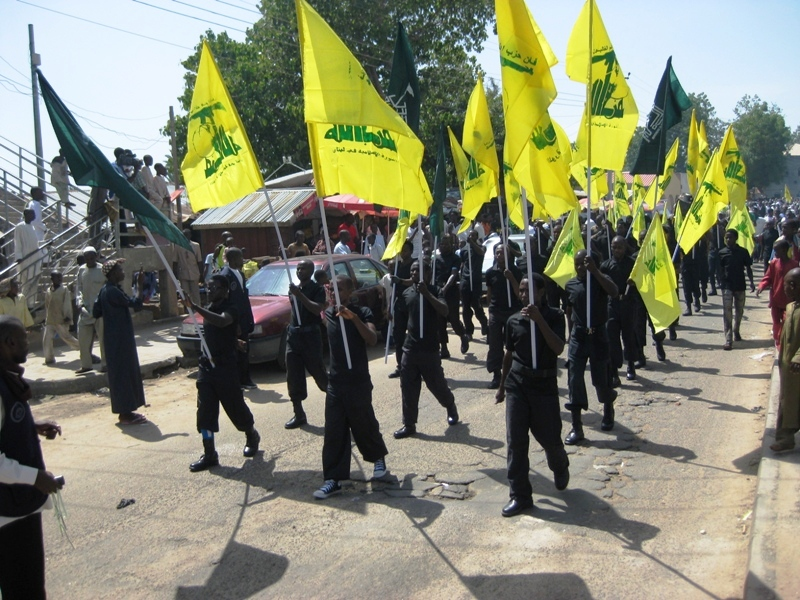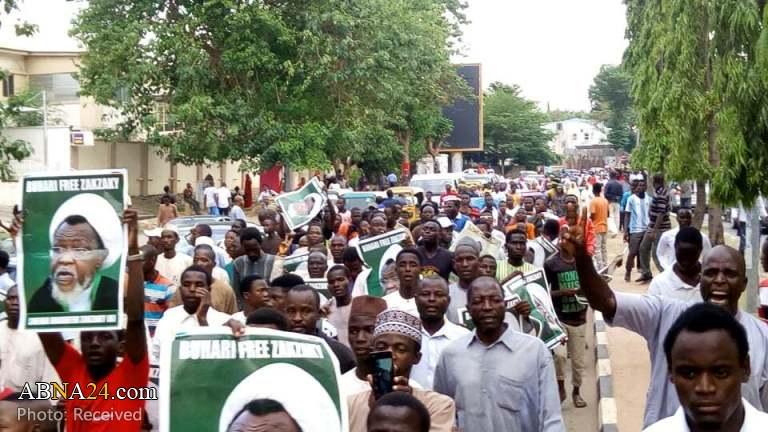Through its outreach efforts, Iran was able to cultivate leaders inspired by Iran’s Islamic Revolution to adopt anti-Western, pro-Iranian Khomeinist ideology, and who subsequently worked with Iranian agents and institutions to spread it on the continent. A key example of this strategy bearing fruit took place in Nigeria, Africa’s most populous nation and the continent’s key oil producer. Nigeria had a virtually nonexistent Shi’a presence as late as 1980, but now has an estimated 3 million Shi’a Muslims who are heavily influenced by Iran. The rapid, extraordinary ascent of Khomeinist Shi’ism in Nigeria is fully attributable to Sheikh Ibrahim Zakzaky, the founder and spiritual leader of the Islamic Movement in Nigeria (IMN), Iran’s key proxy group in Nigeria.
Sheikh Zakzaky, from the northern Nigerian city of Zaria, began his career in Islamist activism during the early 1970s. Zakzaky originally was a devotee of the Sunni Muslim Brotherhood, primarily drawing inspiration from Sayyid Qutb, the Muslim Brotherhood’s main theologian and the intellectual forebear of Salafi jihadist movements such as Al Qaeda. As a radical university activist, Zakzaky served as Secretary General of the Muslim Student Society at his university, and was appointed Vice President of the Society’s international body in 1979. It was during this period that Zakzaky most likely came into contact with Iranian agents. According to the 1984 CIA report, “We know that Iranian recruiters have been active at universities in northern Nigeria, from members of the Muslim community there. In 1983, for example, there were a half dozen Iranians – among them former Iranian diplomatic and military personnel – teaching or studying at northern campuses while actively involved with the Muslim Student Society.”
Zakzaky was ultimately inspired by Iran’s 1979 Islamic Revolution and the teachings of Ayatollah Khomeini to convert from Sunni Islam to Shi’ism. Zakzaky viewed the 1979 overthrow of the Shah of Iran and subsequent establishment of an Islamic government as a model for an Islamic revival in Nigeria. In 1980, Zakzaky, along with other members of the Muslim Student Society, paid a transformative visit to Tehran where they received training to indoctrinate them into Khomeinism with the goal of exporting the Revolution to Nigeria. Upon his return to Nigeria, Zakzaky “adopted the symbolism and rhetoric” of Ayatollah Khomeini and went on to found the IMN as the vehicle for proselytization. His initial activities included “recruitment tours” of northern Nigerian universities to expose students to Iran’s revolutionary principles. His agitation on Iran’s behalf led to numerous conflicts with Nigerian authorities, including a 1981-1984 stint in prison for “sedition and for declaring he would recognize no governmental laws or authority except those of Islam.”
Once out of prison during the mid-1980s, Zakzaky transformed the IMN from a student activist movement to a mass movement bent on gaining converts. Zakzaky himself began wearing the traditional white turban of a Shi’a cleric. According to a U.S. Department of State specialist on Nigeria, Iran funds the IMN to the tune of approximately $10,000 per month, providing a cost effective means to increase their influence among Nigeria’s Muslim population. Using these funds, Sheikh Zakzaky has emulated the Hezbollah model, creating a variegated network of social welfare organizations in order to create patronage links to local Muslim communities, boosting the profile of the IMN and Iran in the process and facilitating the spread of Khomeinist ideology. A March 2017 Bloomberg report, which included interviews with Nigerian Shi’a converts, illustrates the strength of this model in inculcating fealty to the Iranian regime. One subject, who receives a roughly $5 weekly stipend from the IMN, stated he would offer his kids to Iran if called upon by Ayatollah Khamenei, while another said “If Iran wants our help, we are ready to go and help it, even with our blood.”
Using Iranian funding, as well as member donations, Zakzaky’s IMN operates a network of Islamic centers and prayer rooms which are used to propagate Khomeinism, and has established over 300 schools in Nigeria which provide free education to poor families for indoctrination purposes. The IMN’s strength in Nigeria has made the country the main center of Al-Mustafa International University in Africa. Al-Mustafa operates five schools and seminaries in Nigeria with nearly 1000 students from Nigeria and neighboring countries. Al-Mustafa’s presence serves as a pipeline for bringing dozens of Nigerian students each year to Qom for intensive ideological training, and many graduates go on to undertake missionary activities elsewhere in Africa.
The IMN also operates several propaganda organs, including news magazines in English and the local Hausa language, a Hausa-language radio station called al-Shuhada (the martyrs), and the group’s official website, which prominently features the writings and teachings of Zakzaky, Ayatollah Khomeini, and Supreme Leader Khamenei. Iran also runs Hausa TV, which, according to the Iranian Ahlul Bayt World Assembly, is the “first Iranian media outlet that focuses on the African continent.” Its main audience is the Hausa-speaking community. The IMN translates documentaries on Shi’a religious leaders into Hausa, “with hundreds of DVDs sold to eager locals every month.” The IMN’s propaganda and proselytization efforts have spread the movement’s ideology beyond Nigeria, with pockets of support reportedly forming in neighboring Niger, Cameroon, Chad, Burkina Faso and Ghana, giving Iran a nascent doctrinal presence in these countries.
Having amassed a large following through educational and social welfare outreach, Sheikh Zakzaky and IMN clerics work to transmit Iranian-influenced ideology to the group’s backers. Zakzaky frequently gives addresses to his followers while sitting under a portrait of Ayatollah Khomeini, and his speeches center around typical Iranian grievances and conspiracy theories against Israel and Jews, the U.S., and the West. IMN imams “preach that the West conspires to “dominate minds and resources” of Muslims by converting them to Christianity and secularizing them, Jews are the “lowest creatures on earth” and the “children of monkeys and pigs,” the West fabricated the 9/11 attacks on the United States, and the Nigerian government created Boko Haram to justify Western-Christian “occupation” of the Muslim world and northern Nigeria.”
One of Zakzaky’s main targets is Nigeria’s republican government itself, which the IMN, according to its own website, and ostensibly its potentially 3 million members, wish to replace with an Iran-style theocracy predicated on velayat-e faqih. While the IMN claims to be an exclusively peaceful Islamist movement, it has a checkered history of low-level militant activities and confrontations with Nigerian security forces that have led to the imprisonment of hundreds of the group’s members since the 1980s. Both Nigerian intelligence and U.S. embassy cables have reported that the group operates paramilitary training camps in northern Nigeria. The group has hundreds of paramilitary guards, called hurras, who are not armed so as to avoid a direct confrontation with the state, but who “are a uniformed, regimented organization modeled on the Revolutionary Guard that carries Hizb Allah’s flag as their emblem.”
The nature of the IMN’s ties to Hezbollah are unclear, but the groups have a shared ideology and history of contacts which suggests that the IMN may gradually shift into more militant activities when expedient, or if it faces governmental repression. In May 2013, Nigerian authorities charged three Lebanese members of Hezbollah with terrorism and weapons smuggling after unearthing a large weapons cache in the town of Kano which were allegedly meant to target Israeli and Western interests in Nigeria. The seizure indicated that Hezbollah’s presence in West Africa is not just about collecting money, but the group is also planning and conducting militant activities as well.
The IMN denies operational links to Nigeria’s Lebanese community and Hezbollah, but Nigerian security analysts dispute this assertion. According to Cheta Nwanze, head of research at SBM Intelligence, “The Nigerian State has a trove of information linking the IMN with hundreds of Lebanese who are resident in Nigeria, especially Lebanese based in Kano. They strongly believe that this is a basis for coordination with the Hezbollah in Lebanon.” In 2015, Sheikh Zakzaky travelled to Lebanon, where he toured Hezbollah-operated sites and sat for an interview with Hezbollah’s al-Manar TV station, giving further credence to Hezbollah-IMN links.
The IMN frequently mobilizes tens of thousands of its members for Shi’a religious events and mass political demonstrations, many of which feature the burning of American and Israeli flags, and veneration of the triumvirate of Ayatollah Khomeini, Supreme Leader Ali Khamenei, and Hezbollah Secretary-General Hassan Nasrallah. The mass demonstrations have been the site of violence and clashes on occasion. In July 2014, more than 30 IMN members were killed in clashes with government forces during the IMN’s yearly Quds Day procession held to demonstrate IMN’s solidarity with the Palestinian cause. Sheikh Zakzaky lost three sons in the incident.
In December 2015, the IMN was holding a procession when the Nigerian military alleges that attendees attacked a motorcade transporting the army’s chief of staff . The incident touched off several days of clashes which led to the deaths of several hundred IMN members. The Nigerian authorities took Sheikh Zakzaky and his wife into custody, and they remain detained to this day. Iran’s Supreme Leader, President, and foreign minister, as well as Hezbollah Secretary General Hassan Nasrallah, have all called for Zakzaky’s release. His ongoing detention at the hands of Nigerian authorities heightens the prospect that the IMN will step up its militancy in the months and years to come. Despite his penchant for extreme rhetoric, Zakzaky has largely discouraged physical confrontation with the Nigerian state. The IMN has several younger potential successors waiting in the wings who are more “radical and violence-prone” than Zakzaky, further exacerbating concerns of future sectarian strife in Nigeria.
In July 2019, after a number of violent clashes between followers of Zakzaky protesting his imprisonment and Nigerian security personnel, a Nigerian federal court ruled that the IMN was responsible for “acts of violence and illegality,” and therefore granted the government permission to designate the group as a “terrorist organization.” On the day after this court ruling, the President of Nigeria issued a number of tweets, both dictating a ban on the group and explaining that the ban did not mean that members of the movement could not practice their Shi’a religion. IMN followers contend that they are being persecuted by the country’s majority Sunni Muslims. Two years later, a Nigerian court acquitted Zakzaky on all eight criminal charges, most of them having to do with his role in inciting and leading the anti-government protests in 2015 that turned violent.
Following his release, Zakzaky interviewed with the Iranian media outlet Press TV. He used the opportunity to reiterate his call for an Islamic system of government in Nigeria, saying, “Which system would you like? Is it the status quo, which is inherited from the British colonialists or the Islamic system? I’m sure that the majority will choose the Islamic system.” The Iranian regime views Zakzaky as a vehicle for its revolutionary export, with Iranian media outlets hailing him and his followers as the victims of Western domination and oppression. In 2023, the Tehran Times, for instance, alleged that the U.S. and Israel greenlit the Nigerian government’s persecution of the Shia minority population out of their fear of an Islamic resurgence and Islamic governance. In October 2023, Zakzaky traveled to Tehran and was warmly welcomed by Supreme Leader Khamenei, though details of their discussions remain scarce. He also reportedly attended a ceremony at the University of Tehran.


